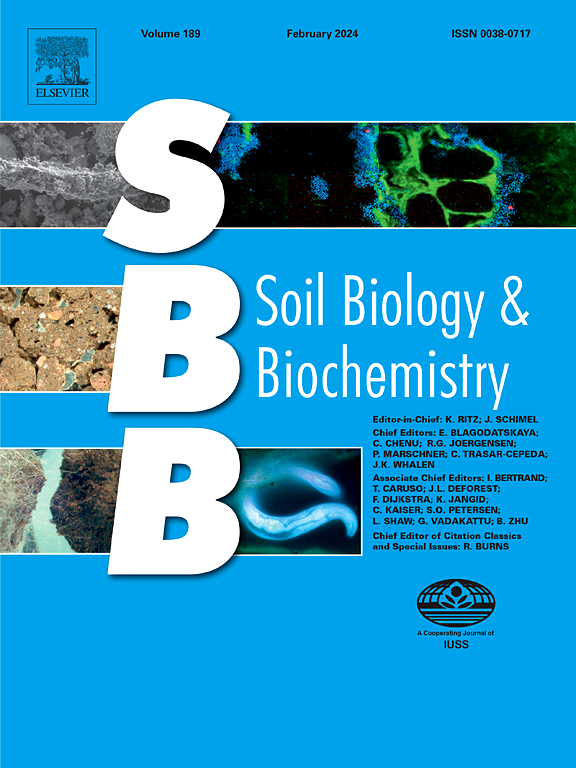Wetland restoration following agricultural abandonment supports diversity and reduces stochasticity in soil fungal communities due to anaerobic-induced interspecific associations
IF 10.3
1区 农林科学
Q1 SOIL SCIENCE
引用次数: 0
Abstract
Soil fungi play a pivotal role in regulating various functions within terrestrial ecosystems. Understanding the progression of soil fungal communities during wetland restoration following agricultural abandonment is essential for assessing the sustainability of rehabilitated ecosystems. Soils along a chronosequence of paddy fields and wetlands restored for 1, 3, and 4 years were studied to investigate the dynamics of fungal diversity and assembly processes, focusing on how these changes relate to species associations and soil environmental factors, particularly redox condition and carbon (C) supply, which predominantly regulate a range of ecological services. Wetland restoration increased both soil fungal taxonomic and phylogenetic diversity. The relative contribution of nestedness increased with restoration duration, emphasising the importance of richness increases in soil fungal community succession during wetland restoration. Concurrently, stochastic assembly processes of soil fungal communities decreased with restoration duration, as indicated by a decline in the phylogenetic normalised stochasticity ratio. However, soil fungal community assembly was decoupled from anaerobic condition (indicated by ferrous iron/ferric iron ratio) and labile C supply (indicated by organic C content and the relative abundance of the di-O-alkyl C functional group). In contrast, the decrease in stochasticity was associated with enhanced species associations, reflected by increases in node number, edge number, and average degree, particularly positive associations, as shown by the rise in the positive-to-negative edge ratio during wetland restoration. This pattern might be because that despite stronger soil anaerobic condition, enriched anaerobic species (e.g., Mortierellales) could provide nutrients to aerobic species (e.g., Helotiales) through positive associations, thereby broadening fungal niche breadth. This, in turn, might cascade into more diversified and less stochastic fungal communities during wetland restoration. Overall, our results suggest that anaerobic-induced interspecific associations reduce stochasticity in soil fungal communities and provide a mechanistic perspective on the protection of soil fungal diversity during wetland restoration following agricultural abandonment.
农业废弃后的湿地恢复支持了土壤真菌群落的多样性,并减少了厌氧诱导的种间关联的随机性
土壤真菌在调节陆地生态系统的各种功能中起着关键作用。了解农业撂撂撂撂地湿地恢复过程中土壤真菌群落的演变,对评估恢复后生态系统的可持续性具有重要意义。研究了稻田和湿地恢复1、3和4年土壤真菌多样性和组装过程的动态,重点研究了这些变化与物种关联和土壤环境因子的关系,特别是氧化还原条件和碳(C)供应,它们主要调节一系列生态服务。湿地恢复增加了土壤真菌的分类和系统发育多样性。巢性的相对贡献随恢复时间的延长而增加,强调了湿地恢复过程中丰富度的增加对土壤真菌群落演替的重要性。同时,土壤真菌群落的随机组装过程随着恢复时间的延长而减少,这表现为系统发育归一化随机比的下降。然而,土壤真菌群落组装与厌氧条件(亚铁铁/三铁铁比)和不稳定C供应(有机C含量和二o烷基C官能团的相对丰度)解耦。随机度的降低与物种关联的增强有关,表现为节点数、边数和平均度的增加,特别是正相关,表现为湿地恢复过程中正、负边比的增加。这种模式可能是因为尽管土壤厌氧条件较强,但富厌氧菌(如Mortierellales)可以通过正关联向好氧菌(如Helotiales)提供养分,从而扩大了真菌生态位宽度。这反过来又会在湿地恢复过程中形成更多样化和更少随机性的真菌群落。总之,我们的研究结果表明,厌氧诱导的种间关联降低了土壤真菌群落的随机性,并为农业废弃地湿地恢复过程中土壤真菌多样性的保护提供了机制视角。
本文章由计算机程序翻译,如有差异,请以英文原文为准。
求助全文
约1分钟内获得全文
求助全文
来源期刊

Soil Biology & Biochemistry
农林科学-土壤科学
CiteScore
16.90
自引率
9.30%
发文量
312
审稿时长
49 days
期刊介绍:
Soil Biology & Biochemistry publishes original research articles of international significance focusing on biological processes in soil and their applications to soil and environmental quality. Major topics include the ecology and biochemical processes of soil organisms, their effects on the environment, and interactions with plants. The journal also welcomes state-of-the-art reviews and discussions on contemporary research in soil biology and biochemistry.
 求助内容:
求助内容: 应助结果提醒方式:
应助结果提醒方式:


